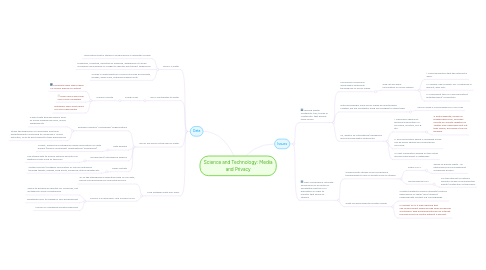
1. Issues
1.1. Leaving Digital Footprints: trail, traces or "footprints" that people leave online
1.1.1. Consumers commonly leave digital footprints through use of social media
1.1.1.1. Why do we share information on social media?
1.1.1.1.1. 1. False perception that the Internet is "safe"
1.1.1.1.2. 2. Monkey-See-Monkey-Do: If everyone is doing it, why not?
1.1.1.1.3. 3. Convenient tool for communication/ entertainment/ connection
1.1.2. With increasingly more social media accounts being created, we are constantly bring encouraged to utilize them
1.1.2.1. Social Media is OMNIPRESENT in our lives
1.1.3. So, what is so intimidating/ dangerous about leaving digital footprints?
1.1.3.1. 1. Excessive sharing of personal information i.e. full name, location, D.O.B etc.
1.1.3.1.1. A Dutch website, known as pleaserobme.com, provides minute-by-minute updates on Twitter users who have just left their house, providing a tool for burglars.
1.1.3.2. 2. Any information which is uploaded online can be easily shared and accessed by ANYONE
1.1.3.3. 3. Most information shared on the virtual remains permanent in databases
1.2. Mass Surveillance: intricate surveillance of an entire or substantial fraction of a population in order to monitor that group of citizens
1.2.1. Governments utilises mass surveillance technologies to spy on private lives of citizens
1.2.1.1. Public P.O.V
1.2.1.1.1. Abuse of human rights - an interference and infringement of people’s privacy
1.2.1.2. Governments P.OV
1.2.1.2.1. For the interest of national security as well as ensuring the safety/ protection of the public
1.2.2. What do governments monitor online?
1.2.2.1. Content related to public interests/ political expressions or ideas/ race/ religion/ inappropriate content e.g. pornography
1.2.2.2. In August 2014 it was reported that law-enforcement agencies had been accessing Australians' web browsing histories via internet providers such as Telstra without a warrant.
2. Data
2.1. WHAT is Data?
2.1.1. Information that is stored or produced by a computer of base
2.1.2. Measured, collected, reported an analysed, whereupon it can be visualized using graphs or images to identify key trends/ behaviours
2.1.3. Comes in large spectrum of forms such as documents, images, audio clips, software programs etc.
2.2. WHO contributes to Data?
2.2.1. EVERYONE
2.2.1.1. In every minute
2.2.1.1.1. Facebook users share nearly 2.5 million pieces of content
2.2.1.1.2. Email users send over 200 million messages
2.2.1.1.3. Instagram users post nearly 220 000 new photos
2.3. WHAT are some of the uses of Data?
2.3.1. Business Owners/ Companies/ Organisations
2.3.1.1. Collect data through means such as online banking services, online shopping etc.
2.3.1.2. Study the behaviour of consumers and tailor advertisements according to consumer's online activities, so as to best market to their preferences
2.3.2. Data Brokers
2.3.2.1. Collect, analyse and categorise useful information for data buyers (usually companies/ organisations/ businesses)
2.3.3. Government/ Intelligence Agency
2.3.3.1. Use stored data to ensure national security e.g. fighting crimes such as terrorism
2.3.4. News Outlets
2.3.4.1. Obtain primary/ firsthand information of real life witnesses through tweets, images, blog posts, Facebook status updates etc.
2.4. LINK between Data and Topic
2.4.1. All of the stakeholders essentially feed on our data, hence compromising our individual privacy.
2.4.2. Privacy is IMPORTANT and SIGNIFICANT
2.4.2.1. Space to develop an identify for ourselves, not dictated by social conditioning
2.4.2.2. Breathing room to engage in self-development
2.4.2.3. Crucial for managing societal pressures
